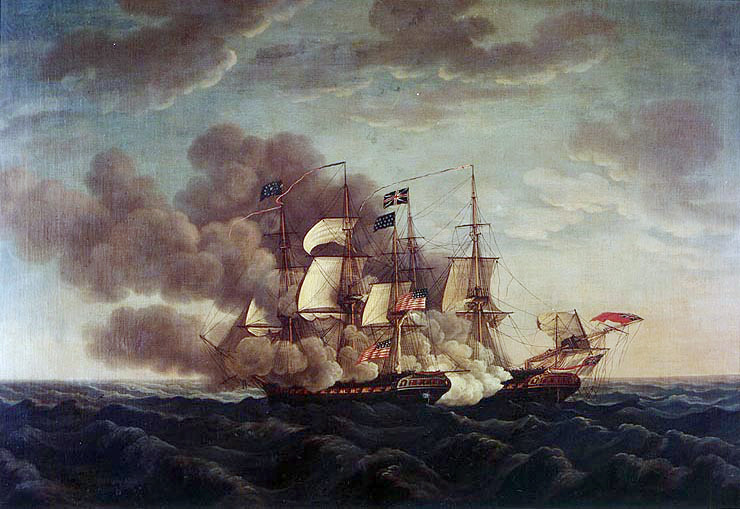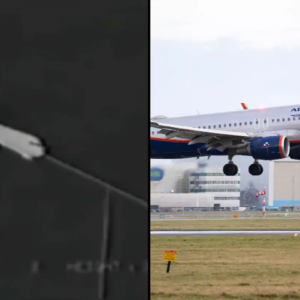USS Constitution vs HMS Guerriere was a battle between an American and British ship during the War of 1812, about 400 miles (640 km) southeast of Halifax, Nova Scotia. It took place on the 19th of August 1812, one month after the war’s first engagement between British and American forces. Guerriere was proceeding to Halifax for a refit, having been detached from a squadron which had earlier failed to capture Constitution. When the two ships encountered each other on August 19th, Guerriere’s Captain James Richard Dacres engaged, confident of victory against the larger, better-armed U.S. ship. The exchange of broadsides felled Guerriere’s masts and reduced the ship to a sinking condition. Constitution’s crew took the British sailors on board and set Guerriere on fire, then returned to Boston with news of the victory, which proved to be important for American morale.
At 2:00 p.m. on 19 August, Constitution sighted a large ship to leeward, and bore down to investigate. The weather was cloudy, and the wind was brisk. The strange ship proved to be Guerriere, whose crew recognised Constitution at about the same moment. Both ships prepared for action, and shortened sail to “fighting sail”, i.e. topsails and jibs only. As Constitution closed, Dacres first hove to to fire a broadside, which fell short, and then ran before the wind for three quarters of an hour with the Constitution on Guerriere’s quarter. Dacres yawed several times to fire broadsides at Constitution, but Guerriere’s broadsides were generally inaccurate, while the few shots fired from Constitution’s foremost guns had little effect. After one cannonball bounced “harmlessly” off the side of Constitution, a crew member is said to have yelled “Huzzah! Her sides are made of iron!”

Once the range had closed to within a few hundred yards, Captain Hull ordered extra sail (the foresail and main topgallant sail) to be set, to close the distance quickly. Dacres did not match this maneuver, and the two ships began exchanging broadsides at “half pistol-shot”, with Constitution to starboard and Guerriere to port. After fifteen minutes of this exchange, during which Guerriere suffered far more damage than Constitution due to the latter’s larger guns and thicker hull, Guerriere’s mizzenmast fell overboard to starboard, acting like a rudder and dragging her around. This allowed Constitution to cross ahead of Guerriere, firing a raking broadside which brought down the main yard. Hull then wore ship to cross Guerriere’s bow again, firing another raking broadside, but the maneuver was cut too close and Guerriere’s bowsprit became entangled in the rigging of Constitution’s mizzenmast.

On both ships, boarding parties were summoned and musket fire broke out. Aboard Constitution, Lieutenant William S. Bush was killed and Lieutenant Charles Morris wounded by musket shots, as was Captain Dacres. Only Guerriere’s narrow bowsprit provided a way between the ships, and in the heavy sea, neither side could venture across it. Some of the gunners aboard Guerriere fired at point-blank range into Hull’s stern cabin, setting the American ship on fire briefly. The two locked ships slowly rotated clockwise until they broke free. Guerriere’s foremast and mainmast both then fell “by the board” i.e. snapped off at deck level, leaving her helpless and rolling heavily. Dacres attempted to set sail on the bowsprit to bring his ship before the wind, but it too had been damaged and broke. The Constitution meanwhile ran downwind for several minutes, repairing damage to the rigging, before once again wearing and beating upwind to return to battle.
As Constitution prepared to renew the action, Guerriere fired a shot in the opposite direction to Constitution. Sensing that this was an attempt to signal surrender, Hull ordered a boat to take a lieutenant over to the British ship. When the Lieutenant boarded Guerriere and asked if Guerriere was prepared to surrender, Captain Dacres responded “Well, Sir, I don’t know. Our mizzen mast is gone, our fore and main masts are gone – I think on the whole you might say we have struck our flag.”
Although the battle was, arguably, inconsequential from a military perspective, as the loss of Guerriere was insignificant to the 600 ship Royal Navy, it was a pivotal moment in American naval history.
The effect of the battle on American morale and patriotism was immeasurable. Prior to the battle, the American land campaign against Canada had been unsuccessful with a resulting loss of public support for the war. After the battle, the American public became galvanized by the pride in defeating the vaunted Royal Navy in a “fair” fight. Although Constitution and Guerriere were both frigates, Constitution carried more guns of larger calibers, stronger scantling[further explanation needed] , as well as 208 additional crewmen and, therefore, had a decisive advantage. This fact was simply overlooked or ignored by the press and the public.
News
The “Red Zone” – Land Still Abandoned Due to the Dangers Left by the First World War
The “Red Zone” – Land Still Abandoned Due to the Dangers Left by the First World War In the aftermath of the First World War, large areas of northeast France were left in ruin. Years of constant siege warfare along…
Before Becoming a Big-Name Actor, Richard Todd was a Paratrooper Who Fought at Pegasus Bridge
Before Becoming a Big-Name Actor, Richard Todd was a Paratrooper Who Fought at Pegasus Bridge Photo Credit: 1. Sgt. Christie, No. 5 Army Film & Photographic Unit / Imperial War Museums / Wikimedia Commons / Public Domain 2. Silver Screen…
The Potsdam Giants: A Prussian Infantry Regiment Of Nothing But Very Tall Soldiers
The Potsdam Giants: A Prussian Infantry Regiment Of Nothing But Very Tall Soldiers Frederick William I inspecting his giant guards known as The Potsdam Giants, a Prussian infantry regiment No 6, composed of taller-than-average soldiers. Frederick William I of Prussia,…
Ellen DeGeneres cuts a very casual figure as she drives around in her Ferrari
Ellen DeGeneres cuts a very casual figure as she drives around Montecito in her Ferrari… while preparing to embark on her stand-up tour Ellen DeGeneres cut a very casual figure as she made her way around Montecito on Tuesday morning. The…
“I’m heavily tattooed and keep getting rejected for jobs – it’s not fair”
Heavily tattooed OnlyFans star, 23, with multiple piercings on her FACE slams TJ Maxx for rejecting her for a job – accusing retailer of unfairly judging her dramatic look A woman has accused TJ Maxx of rejecting her for a…
All 75 passengers killed in plane crash after pilot let his chirldren control the plane
Praying, turning the engine off by accident and letting KIDS play with the controls: The worst blunders made by pilots before a crash revealed Every time we board a plane, we put our lives in the hands of the pilot….
End of content
No more pages to load











